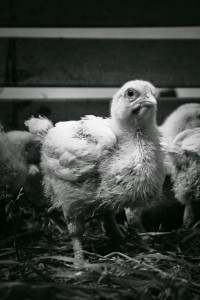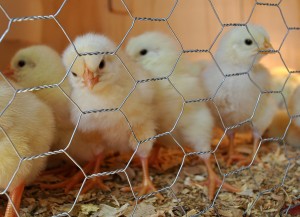The truth behind “free-range” farms

With increased awareness of the inhumane practices occurring at factory farms, more and more people are opting for meat from free-range or cage-free farms. However, as Dr. Charles Olentine, editor of Egg Industry magazine, articulated, “just because it says free-range does not mean that it is welfare-friendly.” Contrary to what many believe, free-range or cage-free farms are remarkably similar to factory farms. Labels such as “free-range,” “cage-free,” “free-run,” and “natural” have yet to be legally defined in Canada. There are currently no laws or regulations in Ontario indicating what these labels signify, nor are there third-party inspectors to oversee operations. Such farms operate according to the honour code and are left to govern themselves.
Just as is done on factory farms, male chicks born to the egg industry on free-range farms are often either thrown in a macerator and ground up alive or disposed of in dumpsters. Since the egg-laying breeds of chickens do not have much meat, it is not profitable to raise them for meat. The female chicks are often debeaked, raised to lay eggs, and slaughtered when egg production slows down, which is generally at only one-and-a-half or two years of age. They are slaughtered at this age despite the fact that chickens can live up to ten years or more.
Free-range and cage-free animals are often housed in overcrowded spaces and may never have access to the outdoors. Further, as our harsh Canadian winters make it difficult to allow chickens to roam outside, only a small percentage of Canadian farms are truly free-range. Scott Akom, an employee of the Horizon Foods Organic and Free-Range Farm confirmed that the chickens at his farm do not have access to the outdoors and explained that it is a free-range farm in that the chickens are free to roam in the chicken house. Although free-range cattle, pigs, and sheep must have “access to the range,” there are no laws in place specifying how much space must be allowed.
Breeding at free-range farms often resembles factory farms. Free-range animals are fed the same antibiotics that factory farmed animals are given. Meat chickens are raised to prematurely reach their goal weight so that they can be slaughtered at forty-five days of age. This premature weight gain strains the chickens’ limbs and causes respiratory problems, heart attacks, and a condition known as “splayed legs.”
Given that the vast majority of farms operate for profit, the practices implemented at such farms are in existence to generate profit. This, unfortunately, is often at the expense of the animals that have become commodities. While small family farms do exist, their numbers pale in comparison to those which claim to be free-range or cage-free yet are strikingly similar to factory farms.

Since there are no regulations regarding sanitation, chickens raised on free-range farms still experience the same ammonia burns on their breasts and have the same lung problems from constantly sitting in their own waste.
Animals raised on free-range, cage-free, or organic farms do not receive special humane slaughter. Free-range animals are killed at the same slaughterhouses as factory farmed animals and are also slaughtered in the same way. They also often travel anywhere from thirty-six to fifty-two hours in the same trucks to get to the slaughterhouses. During the trip, they are not provided with food or water. In 2007, one investigator of a free-range farm reported that eighty thousand hens had been gassed to death within the span of four days.
In order to produce milk for humans, farmers must manipulate the reproductive systems of cows. Calves are taken away from their mothers the moment they are born so that they will not compete with humans for their own mother’s milk. The cow’s reproductive cycle begins again within only two months.
Even on the smallest free-range dairy farms, male calves are thrown out, sold for veal shortly after birth, or are killed within days of their birth for bob veal. Others remain in stalls for months, are unable to exercise and are not given proper nutrients. Within four years, dairy cows are considered “spent” and are slaughtered.
According to new research from Sweden’s national veterinary institute, uncaged chickens are exposed to higher levels of bacteria, parasites, and viruses that put them at greater risk for disease and infection than caged chickens. Housing a large population of uncaged chickens in close proximity allows disease and infection to spread quickly. Such an arrangement also leads to higher rates of pecking which can result in disease or death.
Therefore, despite what many may believe, free-range or cage-free farms are not the better option for those wanting to eat ethically.
